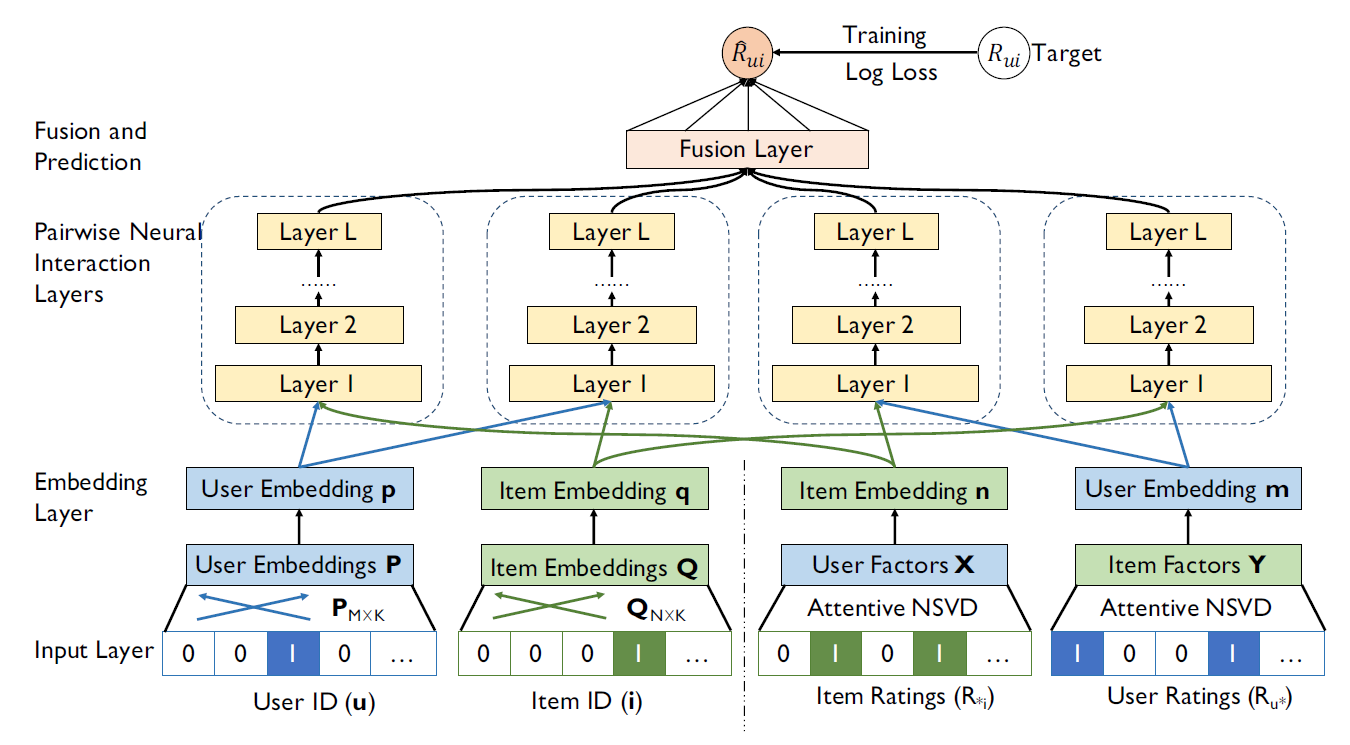Dual Embedding based Latent Factor Model
Based on the following lectures
(1) “Recommendation System Design (2024-1)” by Prof. Ha Myung Park, Dept. of Artificial Intelligence. College of SW, Kookmin Univ.
(2) "Recommender System (2024-2)" by Prof. Hyun Sil Moon, Dept. of Data Science, The Grad. School, Kookmin Univ.
Embedding Type
- 아이디 임베딩(ID Embedding)
- Embedding user and item identifiers into a low-dimensional vector space
- 사용자의 고유한 선호 정보나 아이템의 고유한 특징 정보를 반영한 표현을 도출함
- 사용자와 아이템의 맥락 정보가 부족하여 행동 패턴이나 구매 패턴을 반영하기 어려움
- 히스토리 임베딩(History Embedding)
- Generate each user and item expressions based on past interaction history
- 사용자의 행동 패턴이나 아이템의 구매 패턴을 반영한 표현을 도출함
- 사용자와 아이템을 상호간에 의존하여 표현하므로 고유 정보를 보존하기 어려움
DNCF
- 문제 의식: 아이디 임베딩(ID Embedding)과 히스토리 임베딩(History Embedding)의 분리로 인한 표현력의 제약
DELF는 아이디 임베딩과 히스토리 임베딩을 분리하여 매칭 함수 학습을 수행함- 각 표현이 서로의 표현력을 보완하거나 강화하지 못함
DNMF(DeepNeuralMatrixFactorization): 아이디 임베딩과 히스토리 임베딩을 결합한 하나의 표현을 생성하여NeuMF의 표현력을 강화하는 앙상블 모형- He, G., Zhao, D., & Ding, L.
(2021).
Dual-embedding based neural collaborative filtering for recommender systems.
arXiv preprint arXiv:2102.02549.
- He, G., Zhao, D., & Ding, L.
- Components
DGMF:Dual-Embedding basedGeneralizedMatrixFactorizationDMLP:Dual-Embedding basedMulti-LayerPerceptronDNMF:DGMF&DMLPEnsemble
Notation
- $u=1,2,\cdots,M$: user idx
- $i=1,2,\cdots,N$: item idx
- $\mathbf{Y} \in \mathbb{R}^{M \times N}$: user-item interaction matrix
- $\overrightarrow{\mathbf{p}}_{u} \in \mathbb{R}^{K}$: user ID embedding vector
- $\overrightarrow{\mathbf{q}}_{i} \in \mathbb{R}^{K}$: item ID embedding vector
- $\overrightarrow{\mathbf{m}}_{u} \in \mathbb{R}^{K}$: user history embedding vector
- $\overrightarrow{\mathbf{n}}_{i} \in \mathbb{R}^{K}$: item history embedding vector
- $\overrightarrow{\mathbf{u}}_{u}$: user embedding combination vector
- $\overrightarrow{\mathbf{v}}_{i}$: item embedding combination vector
- $\overrightarrow{\mathbf{z}}_{u,i}$: predictive vector of user $u$ and item $i$
- $\hat{y}_{u,i}$: interaction probability of user $u$ and item $i$
How to Modeling
-
\[\begin{aligned} \hat{y}_{u,i} &= \sigma(\overrightarrow{\mathbf{w}} \cdot [\overrightarrow{\mathbf{z}}_{u,i}^{\text{(DGMF)}} \oplus \overrightarrow{\mathbf{z}}_{u,i}^{\text{(DMLP)}}] + \overrightarrow{\mathbf{b}}) \end{aligned}\]DNMFisDGMF&DMLPEnsemble
DGMF
-
ID Embedding:
\[\begin{aligned} \overrightarrow{\mathbf{p}}_{u} &=\text{Emb}(u)\\ \overrightarrow{\mathbf{q}}_{i} &=\text{Emb}(i) \end{aligned}\] -
History Embedding:
\[\begin{aligned} \overrightarrow{\mathbf{m}}_{u} &=\frac{1}{\sqrt{\vert \mathcal{R}_{u}^{+} \setminus \{i\} \vert}}\mathbf{W} \cdot \mathbf{Y}_{u*}\\ \overrightarrow{\mathbf{n}}_{i} &=\frac{1}{\sqrt{\vert \mathcal{R}_{i}^{+} \setminus \{u\} \vert}}\mathbf{W} \cdot \mathbf{Y}_{*i} \end{aligned}\] -
Embedding Combination:
\[\begin{aligned} \overrightarrow{\mathbf{u}}_{u} &= \text{Agg}(\overrightarrow{\mathbf{p}}_{u}, \overrightarrow{\mathbf{m}}_{u})\\ \overrightarrow{\mathbf{v}}_{i} &= \text{Agg}(\overrightarrow{\mathbf{q}}_{i}, \overrightarrow{\mathbf{n}}_{i}) \end{aligned}\]- element-wise sum
- element-wise mean
- concatenation
- attention
-
Predictive Vector of user $u$ and item $i$:
\[\begin{aligned} \overrightarrow{\mathbf{z}}_{u,i} &= \overrightarrow{\mathbf{u}}_{u} \odot \overrightarrow{\mathbf{v}}_{i} \end{aligned}\] -
If use
\[\begin{aligned} \hat{y}_{u,i} &= \sigma(\overrightarrow{\mathbf{w}} \cdot \overrightarrow{\mathbf{z}}_{u,i} + \overrightarrow{\mathbf{b}}) \end{aligned}\]DGMFas a single prediction module:
DMLP
-
ID Embedding:
\[\begin{aligned} \overrightarrow{\mathbf{p}}_{u} &=\text{Emb}(u)\\ \overrightarrow{\mathbf{q}}_{i} &=\text{Emb}(i) \end{aligned}\] -
History Embedding:
\[\begin{aligned} \overrightarrow{\mathbf{m}}_{u} &=\frac{1}{\sqrt{\vert \mathcal{R}_{u}^{+} \setminus \{i\} \vert}}\mathbf{W} \cdot \mathbf{Y}_{u*}\\ \overrightarrow{\mathbf{n}}_{i} &=\frac{1}{\sqrt{\vert \mathcal{R}_{i}^{+} \setminus \{u\} \vert}}\mathbf{W} \cdot \mathbf{Y}_{*i} \end{aligned}\] -
Embedding Combination:
\[\begin{aligned} \overrightarrow{\mathbf{u}}_{u} &= \overrightarrow{\mathbf{p}}_{u} \oplus \overrightarrow{\mathbf{m}}_{u}\\ \overrightarrow{\mathbf{v}}_{i} &= \overrightarrow{\mathbf{q}}_{i} \oplus \overrightarrow{\mathbf{n}}_{i} \end{aligned}\] -
Predictive Vector of user $u$ and item $i$:
\[\begin{aligned} \overrightarrow{\mathbf{z}}_{u,i} &= \text{MLP}_{\text{ReLU}}(\overrightarrow{\mathbf{u}}_{u} \oplus \overrightarrow{\mathbf{v}}_{i}) \end{aligned}\] -
If use
\[\begin{aligned} \hat{y}_{u,i} &= \sigma(\overrightarrow{\mathbf{w}} \cdot \overrightarrow{\mathbf{z}}_{u,i} + \overrightarrow{\mathbf{b}}) \end{aligned}\]DMLPas a single prediction module:
This post is licensed under
CC BY 4.0
by the author.

